A set of items should be chosen according to the commands and tricks that have been chosen to learn. For complex elements, you may need bollards and chairs or other comfortable furniture – at the owner's discretion.
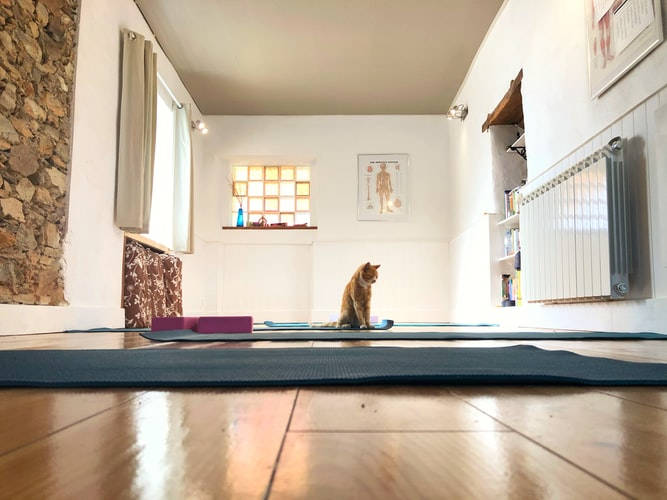
- Questions to the zoopsychologist about cat games
- Features
- What to avoid
- Do not use your hands or feet.
- Can cats be trained?
- When should you start training a cat?
- What you shouldn't do in any case.
- What about adults?
- How to get your cat to like you
- How to get along with a cat
- How to play with your cat and what to do if she bites and lets her claws out!
- The basics of cat training
- At what age to start
- Techniques and tricks
- Which breeds are best trained?
- How to properly play with a Cat?
Questions to the zoopsychologist about cat games
I've been getting a lot of questions from subscribers lately about cat games. Although I have already written many articles about games and even made one video, I decided to answer the most popular questions in another article.
There are cats who are easily interested in a bow on a string and they are ready to run after it all day, and there are those who bought up half of the pet store, and they kicked every toy one time and abandoned it. In the second case, you will have to make a little more effort to motivate the cat to play.
It should be said that play behavior is instinctive, and the instinct is triggered in every cat if the correct key stimulus is presented. The key stimulus in this case will be the sight of the prey, the smell of the prey, the movements of the prey, the touch of the prey, the sound of the prey's voice, etc.
So you must first choose attractive toys that resemble birds, mice, caterpillars and cockroaches. Recently I wrote an article about attractive toys for cats, according to feedback from my readers, you can see some examples there. I advise to choose toys of feathers, fur, with long strings and string, emitting attractive sounds (with sound chips or filled with rice, balls or other filler that emits soft noises). I usually cut the bells off the toys, as the cat's prey does not ring in nature, usually.
It's very important to play with your cat properly! For adult cats, the most proper play is with rods and flappers. Not all your movements will include play instinct and make the cat hunt for a toy feather on a string. Try to move the toy away from the cat and across its field of vision. You don't want to throw the rod at the cat or stick the toy in the cat's face. Try to make the toy "run away" from the cat, hiding in boxes, tunnels, around the corner of the couch. You can see how to properly play with your cat in my video here:
You can also make toys more appealing by rubbing catnip or matatabi on them.
Features
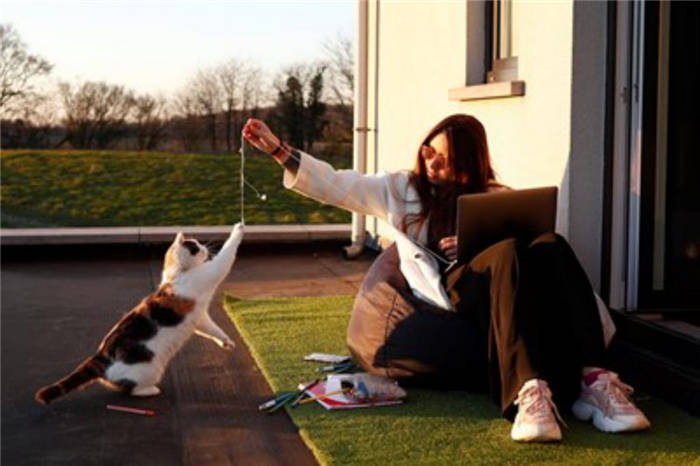
With the exception of illness, there aren't many reasons why a cat refuses to play. She may be too old, or she simply may have become bored with the toys you have.
If the pet is bored with the toy, try hiding it for a while: the pet will quickly forget its moods and in a couple of weeks will happily "pounce" on the familiar bear cub. Or maybe you just need to buy a new, albeit exactly the same toy.
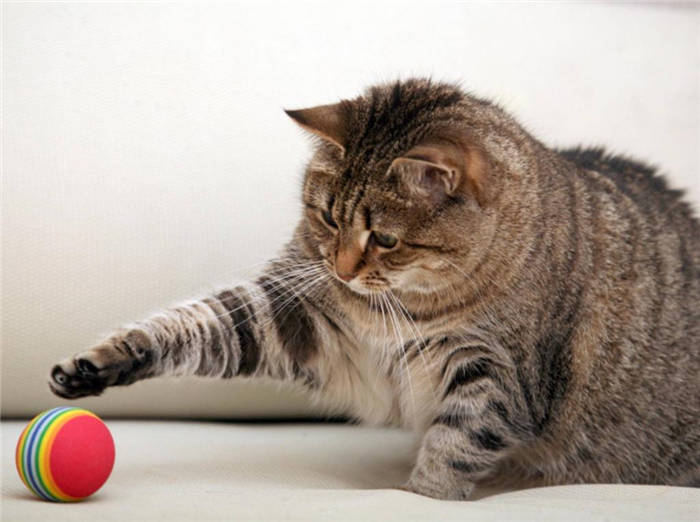
Also consider your cat's interests: if the cat likes battery-operated toy mice that roll around on the floor, inviting it to play with an ordinary ball may not be the best solution.
As the cat gets older it becomes calmer: in order to continue to have fun together, try a system of rewards. This may encourage him to be more active and playful.
What to avoid
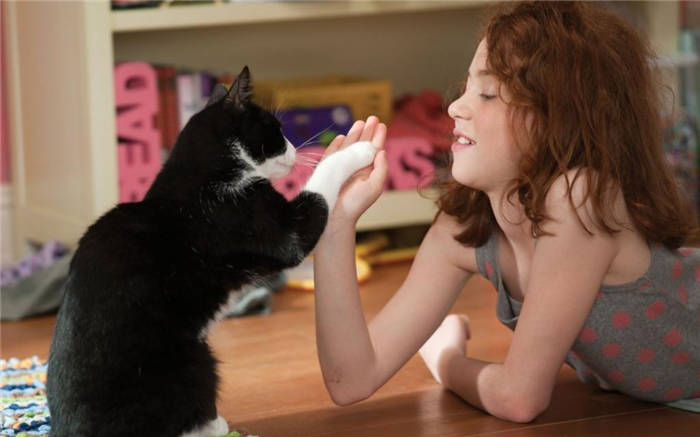
The first and most common mistake in playing with a cat is using your hands or fingers. Why? Such an approach causes an appropriate reflex in the animal: the pet begins to perceive your body as its prey! That's why after such games your hands may be covered with numerous scratches and bites.
Remember: your body should not play the role of a toy. As soon as you notice that the cat follows your hand with the intention of jumping in and grabbing it with his paws, show him that it is not a toy but a source of love and affection. Gently and gently pet the cat and also talk to it affectionately. Don't let anyone annoy your pet with their hands, and don't do it yourself.
Do not use your hands or feet.
Avoid using your limbs or any part of your body to play with your cat, no matter how cute or enticing it is. By doing this, you reinforce this type of behavior and tell your cat that they are allowed to bite and scratch you at any time, which can encourage unwanted behavior and potentially lead to injury.
It is important to keep in mind that there is no one toy that will meet all of your cat's needs. Cats are curious animals, so it is important for them to have a wide variety of toys at their disposal. It is recommended that you alternate between different types of toys to keep your pets interested. When looking for attractive toys, look for realistic products that bear a resemblance to their prey. Cats also like toys that reflect light or have different textures.
Can cats be trained?
No one is surprised by trained dogs – you can train your own pet without much difficulty by yourself or quickly and with a professional trainer. But here the trained cats are a delight to us – not for nothing the show of Yuri Kuklachev fascinates a lot of people. All because it is believed that cats, unlike dogs, like to be "by themselves" and do not obey commands.
Although cats are indeed harder to train than dogs, they can willingly obey some commands. Also, as Daniel Cummings of the animal charity Cats Protection points out in his article, training cats is a way to improve their behavior. For example, you can teach your pet to do the words "come to me," "stand," "jump," "sit," and "give me your paw. But to make it work, it is important to follow a few rules. Firstly, at the moment of training the cat should not be frightened, the pet has to understand that he is safe and that the training is just a game. Remember that cats get tired quickly and can't do more than 30 minutes of one thing – they just get bored. It is important to train regularly, to be patient and not to punish failure.
It is important that reinforcement of successful command performance be only positive. More often than not, trainers use food as a reward for doing the exercise correctly. Some cats don't like to eat so much – then you need to look for another type of reward, such as stroking or scratching.
Alesya Pavlova, a veterinarian and zoopsychologist, told TechInsider about whisker training: Training cats is not a myth; they are excellent trainers. Most of the time they will like it. But it's worth remembering: all cats are different and some will be more interested in training and some less. If the cat doesn't want to be trained you shouldn't force it, but to motivate it to do something for a tasty bite – it's quite a working tactic, which perfectly develops the cat's intellect.
When should you start training a cat?
Of course, you should start training kittens at an early age, but you should not try to teach commands to a newborn animal. The best age to start training is 7-8 months. By this time, the kitten will be able to understand what is required of him and follow the command-reward pattern. For the first training sessions, it is better to choose commands that will resonate with the pet's favorite activities. For example, if the kitten likes to jump and climb on furniture, you can teach it to climb on your shoulders, if it likes to carry objects in its teeth – teach it to bring you a thrown toy.
Teaching commands to an adult cat is difficult, but possible. Over the years the cat develops its own personality and habits. This is why the process of training will be more painstaking and will take longer than with kittens, but if you approach it correctly and with love – everything can work out.
What you shouldn't do in any case.
But there are three basic rules to follow when playing with both kittens and adults.
1) Do not pet or kick the cat. She will not appreciate this. The least patient cat may even provoke aggression. Only after the game is over should you pet the cat, thereby showing it is a good hunter.
2) The game must involve the toys, not your hands! Otherwise, it will be very difficult to wean the cat. You should, because you've shown her that you not only can hunt your arms (and legs), but that you have to!
3) Don't abuse the laser pointer. If it is worth using it, it is only for the first attraction, and when this stage is passed it is better to go to conventional toys. All because the game for a cat must have a stimulus, to give some positive reinforcement. And since the game is a kind of hunting, catching the prey will be such. The cat won't catch the "light", it will gradually become angry and irritated (because failure does not motivate anyone), and in the end it may lose interest in games at all. The same goes for all other toys – the hunt must necessarily end with the cat catching the "prey".
What about adults?
We found out that kittens need to play by all means, but do adult cats need games? Absolutely! Adult cats play, too, and do so almost as willingly as kittens. It's easy to see this when you visit the Murkosha Center. Even in a confined space, cats tend to play, often trying to attract guests.
In general, this is an instinct inherent in nature. Ignoring it, in addition to a certain discomfort for the cat, can lead to very serious consequences.
In the natural habitat of their wild ancestors, hunting was the most important part of life, nature prepared them for it. Now the domestic cat, on the other hand, gets its food without expending its energy on hunting. This can lead to one of two problems (often both at once): either the cat becomes obese because of his passive lifestyle, or he finds ways to get rid of the extra energy on his own. Often the owners do not like these ways, because overturned things, damaged furniture, excessive nighttime activity (since cats are prone to a nocturnal lifestyle) can be the result.
All this is quite easy to avoid if you play with the cat at least 3 times a day for 10-15 minutes. And, according to specialists, it is better to do it before giving the cat food. This way the natural life cycle of a cat will be imitated: "hunting" (remember: it's important to let the cat catch his prey) – eating – washing – sleeping. This will make your cat's lifestyle quite active (assuming playtime is organized correctly), and the problem of excess energy will also disappear.
How to get your cat to like you
wikiHow operates on the principle of a wiki, which means that many of our articles are written by multiple authors. When this article was created, 53 people(s) worked on editing and improving it, including anonymously.
Number of sources used in this article: 24. You will find a list of them at the bottom of the page.
By nature, cats are more independent than dogs. [1] X Source of Information It may seem like a cat doesn't need anyone, but in fact, cats can become very attached to humans. Her affection will help you strengthen your relationship with her. All cats have different personalities, so it may take a while to become friends with a cat. But don't worry – the more the cat likes you, the happier it will be and the more enjoyable your time with it will be.
How to get along with a cat
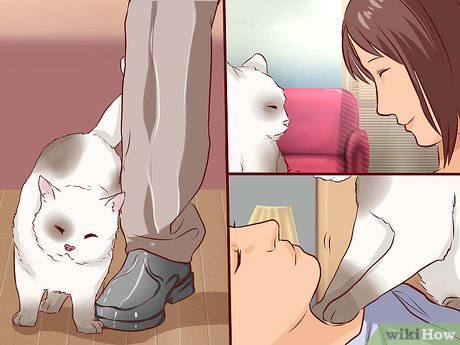
- Near its ears there are glands that secrete a substance with a peculiar odor. A cat will rub itself against something or someone to get its scent. [3] X Source of information A cat may rub its cheek against you to mark you with its scent. [4] X Source of Information This is a sign that the cat likes you.
- If a cat likes you, it may look into your eyes and blink slowly. Eye contact indicates that the cat trusts you. [5] X Source of information Slowly blink back to show the cat that the trust is mutual.
- Try repeating the cat's actions: rubbing against it, winking slowly. This will strengthen your bond and let the cat know you like it.
- Cats can also express their affection by purring, writhing their paws, wanting to sit on your lap, or licking you. [6] X Source of information [7] X Source of information
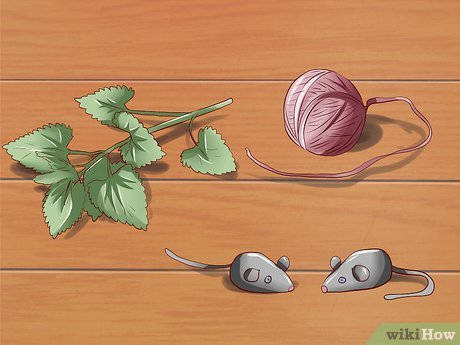
- If your cat is older or more sedate, she may like toys she doesn't have to run after-such as a catnip pad you can play with while lying on her side. [9] X Source of Information
- Alternate toys so the cat doesn't get bored. [10] X Reliable source The Humane Society of the United States Go to Source
- If you don't want to spend a lot of money on toys, make them from what you have at home. For example, you could offer the cat a roll of toilet paper or paper towel or a bag without handles. [11] X Reliable source The Humane Society of the United States Go to source
- Remember that a cat should not play with ribbons, strings, and thin rubber bands because she can swallow them and they can get lodged in her intestines. This will cause complications that require urgent veterinary intervention. Problems with blockages in the intestines can even cause the animal to die.
- Be careful with toys that have small components, such as plastic eyes, which the cat can rip off and swallow. [12] X Reliable source The Humane Society of the United States Go to source
- If you're not sure which toys are right for your cat, talk to your veterinarian or a salesperson at a pet supply store.
How to play with your cat and what to do if she bites and lets her claws out!
You'll wonder – what dangers can lurk in play?
In fact, there are several common mistakes that will not only make your playing with your cat unhelpful, but will also reinforce undesirable habits and may even be counterproductive to your cat's upbringing.
Some mistakes in play technique can even contribute to behavioral problems. The technique cats use to hunt is sprinting after and frantically wrestling with their prey. Here are three common mistakes owners make when playing with cats:
Don't use your hands as toys!
Wiggling your fingers is certainly handy if your cat is nearby and in the mood to play, but here's what really ends up happening: you're sending the cat the message that biting a human is acceptable behavior. If a cat learns that biting during play is allowed, it thinks that biting is an acceptable and effective form of communication in case it wants to express its desires or point of view about what is going on around it. These desires may be that she wants attention, or maybe she wants to be left alone. So the next time you go to the vet or are slicing meat on the cutting table, don't be surprised that it may come to self-harm from the cat and hurt your ankles or hands.
Your cat's association with human hands should only be that the hands are used for gentle petting and stroking. If they are also seen as toys, this can lead to painful injuries. Imagine if a kitten decided to playfully bite a family member other than you. That family member could be a young child or an elderly relative. Don't send messages to the cat about being allowed to bite even when it is done in game.
I can give you an example from my experience. My cat Tisha came to me as a little kitten and was always biting. I first tried to wean him off it, but then I failed and let it be… after all, it is so nice when a baby grabs your hand with his paws and bites furiously… it makes you feel so good… And Tisha decided that biting, that's how he communicated with people and with his own kind. Now he is always biting while playing… only he is biting other cats now. No, he does not beat them or attack them with anger… he just rolls them on the floor (as I did when he was a baby) and bites them. But it bites sometimes painful… cats shriek sometimes.
And what do you think, that was the end of the consequences of my mistake? No! When Kira came to my house, she could not bite at all. I mean, she couldn't think of biting a human at all. It seems to me that even if they hurt her very much, she still wouldn't bite. But, a year went by, and realizing that in this family biting is very much allowed… at the next batch of injections Kira bit into my hand… She was, of course, immediately frightened of what she had done… all squeezed… let go of my hand… but the fact! It was a start.
Anyway, now I have two biters… that came from one of my parenting mistakes. Don't make that mistake again, don't play with cats with your hands!
The basics of cat training
There are a few basics necessary for successful cat training. If these conditions are met, the classes will be comfortable for the pet and calm for the owner.
At what age to start
There is a well-established opinion that kittens begin to understand what their owner requires from them at about three months of age. Accordingly, the optimal age for any training is from three months to one year. In this case, the peak of activity and perception occurs at 7-8 months of age. At the same time, the kitten's propensities for certain actions and tricks appear.
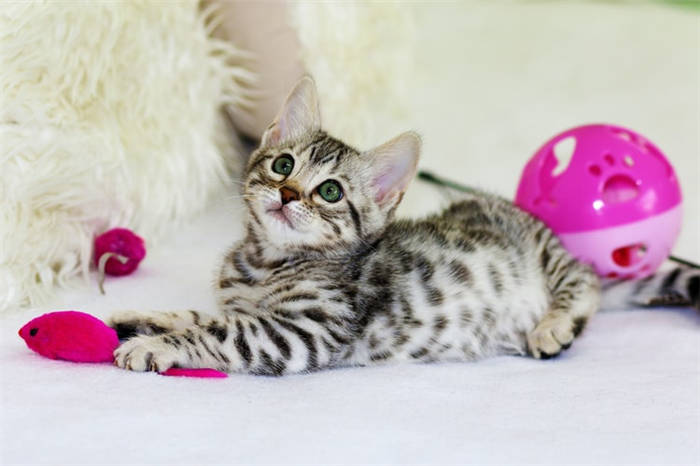
Techniques and tricks
Training of a cat must take place in a calm environment, preferably one-on-one. It's optimal to hold classes in the daytime or in the evening not later and not earlier than 3-4 hours after feeding. The activity should be comprehensive, going from simple to complex and not overtiring for the cat.
The room should be spacious and comfortable for you and the cat. There should be no distractions. The equipment is also better to prepare in advance.
Training should take no more than 10 minutes per approach. Number of approaches – 2 or 3 per day. Each "trick" should be repeated at least 4-5 times. This will help bring the execution of the command to automatism.
The cat must be encouraged. The reward is pre-prepared pieces of meat, fish or other treats. Foods that the cat has to chew are not suitable – it will be distracted from the main training. Reward with food exactly at the moment when the cat has done the trick, but not later than 10-20 seconds – otherwise the pet won't understand that the encouragement is connected to its success.
It is necessary to pet the cat and show attention as additional encouragement. Over time, when the cat learns to perform commands clearly and quickly, food should be rewarded every third to fifth time, and the rest should be given only affection.
Which breeds are best trained?
All breeds perceive training differently – and even have different training abilities. Pedigree cats differ from purebreds in both their easy-going nature and their quick comprehension.
Who else stands out for their intelligence and good understanding of humans:
- Scottish lop-eared – Cats of this breed love to move, and they are also very attached to their owner and adore spending time with him. It is an optimal breed for training – Scots can learn more commands and tricks in less time.
- The Thai cat is – is active, receptive and picks up intonations of her owner's voice perfectly. Easy to learn and train because of its abilities.
- Cornish Rex . – Cats of this breed see training as a kind of game. And they like to play more than anyone else, so they learn well during these games and get tired of them less.
- Abyssinian cat – An intellectual among relatives. These cats are able to learn some commands and tricks even without special training and training, just in the process of playing or communicating with the owner.
Breedless cats show different abilities to learn. Mostly it depends on their character and previous life. A cat raised in a family will understand humans better than one taken from the streets at an advanced age.
In addition to the breed, it is necessary to rely on the character of the particular animal – there are lazy Scots, and amazingly agile ragdolls. If you want, any cat can be taught at least a little trick.
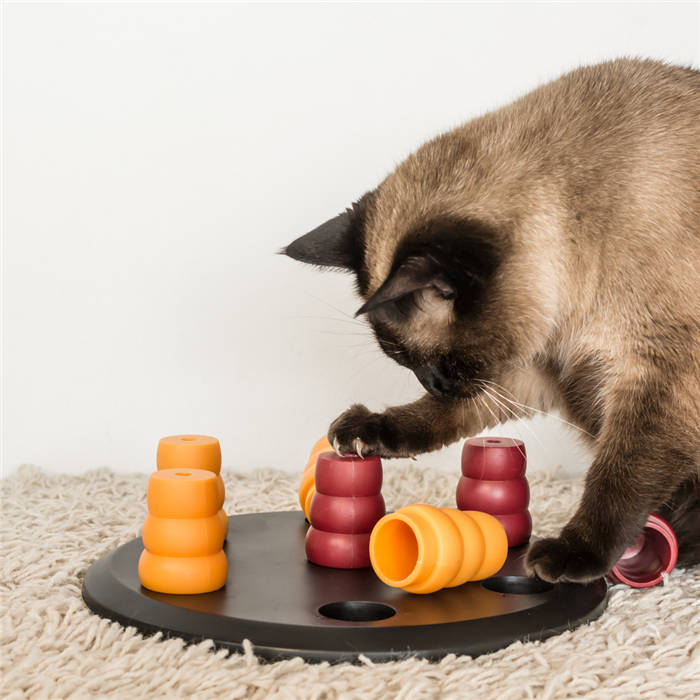
How to properly play with a Cat?
Game mechanics: We'll need a waggle and a scratching post. Motivate the cat to chase the waggle on the scratching post (vertical or horizontal). While playing the game the cat will claw at the scratching post applying pheromones from under the claws to the surface, and later it will help the cat to find the place where it is necessary to sharpen the claws.
A good variant for the correction of aggression + for providing the necessary motor activity, also works for fearful cats, which need to accustom to show initiative.
We take a chair, any small blanket or unnecessary towel, weigh it on the chair seat to make a shelter. We play so that the cat can hunt from hiding, then we hide it, then we show it, we lead it above the cat's level of vision, then along the floor, imitating a bird that moves, but does not fly away.
We hide part of the waving under a plaid or towel, stick out the waving and lead it completely under the fabric, motivating the cat to catch the prey. In this game there is an intrigue for the cat, so it is very interesting to catch the toy 👋 Also you can use a jingle ball, jingle it and partially hide it. Over time, you can hide it deeper to make the search longer.
Very active, involves jumping for a toy, you can chase the cat though the whole apartment, though the chosen room, the main thing is that the game takes place at different levels (remember the picture with the vision of a cat? When for us in the apartment is only a couple of levels, and for a cat much more). It is important not to motivate the cat to jump on surfaces where it is usually forbidden to jump (dinner table, shelves), choose surfaces that are allowed and accessible to the cat at all times.
Let's call it twilight )))) while playing, try to dim the lights, this can be done either in the evening or by curtains. Cats are very sensitive to visual stimuli in semi-darkness and their instincts tell them to hunt exactly by twilight, that's why, for example, many cats hunt under the covers at night – there is a combo, semi-darkness, obstacle to catch in the form of cloth and excitement, because the "prey" is always hiding )






